MYTHS
Myth #1: Coronary Heart Disease Is a Disease
That Affects Primarily Men
Coronary Heart Disease Coronary heart disease constitutes a major public health concern and has a substantial impact on utilization of U.S. health care resources (see Table 23.1). Coronary heart disease continues to be the leading cause of death for men and women in the United States. Age-adjusted death rates in the United States for men and women with cardiovascular disease (i.e., CHD and stroke) are similar and far outnumber deaths from all the other major causes (see Figure 23.1). In addition, cardiovascular disease deaths are more than double the combined total number of deaths from other major causes of mortality in women (including maternal mortality and uterine, ovarian, cervical, breast, and lung cancers). As demonstrated in Table 23.2, CHD is the leading cause of death for women over the age of 65 and the second-leading cause of death for perimenopausal women. This is in contradistinction to the pattern seen for men, where heart disease is the leading cause of death from middle age on. Therefore, CHD is significantly more age dependent in
| Women | Men | |
|---|---|---|
| SOURCE: Wenger et al., eds., Cardiovascular Health and Disease in Women. Greenwich, Conn: LeJacq Communications, 1987. | ||
| Population | 125 million | 118 million |
| Deaths | 244,000 | 268,000 |
| Hospitalizations | 0.9 million | 1.3 million |
| Physician office visits | 4.4 million | 5.8 million |
| Prevalence | 3.0 million | 4.2 million |
| Health expenditures | $6 billion | $9 billion |
| Age | |||
|---|---|---|---|
| 25–44 | 45–64 | 65+ | |
| SOURCE: National Center for Health Statistics. | |||
| Women | |||
| 1 | Cancer | Cancer | Heart disease |
| 2 | Accidents | Heart disease | Cancer |
| 3 | Heart disease | Stroke | Stroke |
| Men | |||
| 1 | Accidents | Heart disease | Heart disease |
| 2 | HIV infection | Cancer | Cancer |
| 3 | Heart disease | Accidents | Stroke |
Myocardial Infarction Epidemiologic data for myocardial infarction (MI) show striking gender-related differences. Perhaps the most extensive data available come from 26 years of observation in the Framingham Heart Study.2 For example, the mean age at presentation of MI was greater for women than for men (see Figure 23.2). Interestingly, of the three major presentations of CHD (sudden death, MI, and angina), the first two are significantly more common in men, whereas angina was
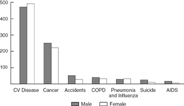
Figure 23.1. Leading causes of death in men and women in the United States (in thousands), 1987. Abbreviations: CV, cardiovascular; COPD, chronic obstructive pulmonary disease; AIDS, acquired immune deficiency syndrome.
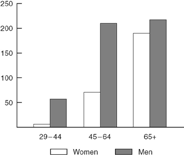
Figure 23.2. Heart attacks in the United States (in thousands). Adapted from American Heart Association, based on the Framingham Heart Study.
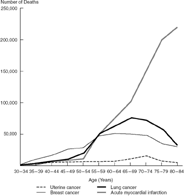
Figure 23.3. Number of deaths by cause and age in U.S. women (all races), 1988. Source: National Center for Health Statistics, Vital Statistics of the United States, Vol. II, Mortality, Part A (Washington, D.C.: U.S. Public Health Service, 1991).
Postinfarction outcomes have been investigated by a number of studies 3–5 and demonstrate higher initial and long-term mortality for women as opposed to men, higher complication rates, and higher reinfarction rates. The role of ethnicity in mortality outcome from MI was highlighted by data from the Multicentre International Survival and Limitation of Infarct Size (MILIS) Trial,6 which demonstrated that whereas combined mortality 48 months postinfarction was higher for women than for men (36% vs. 21%), African-American women had the highest postinfarction mortality, 48%. The reasons for the differences observed in the MILIS trial are incompletely understood but may relate to ethnic differences associated with cardiac risk factor prevalence, socioeconomic factors, and genetic predisposition.
Stroke In part because of the rapid decline in stroke rates in the United States in the last 40 years,7–9 cerebrovascular accident (CVA) in women has received less attention than CHD. Yet CVA is an important entity in cardiovascular disease in women and, like MI, demonstrates significant gender and ethnic differences.10 In general, stroke rates are uniformly higher among African-American men and women than they are for Caucasian men and women. Although deaths from CVA in men outnumber those for women by 30%,9 women are more likely to have fatal strokes than men.7,10 Furthermore, stroke mortality among African-American women is nearly two times that of Caucasian women until age 85, at which point the ethnic and gender trends for stroke are reversed, with Caucasian women having the highest mortality.11 Gender differences in the association between stroke and blood pressure, the strongest and most consistent risk factor for CVA, have not been reported. Like for CHD, the economic and social impact of CVA is immense. The highest percentage of nursing home admissions in the elderly (age 65) are due to disability from stroke; women comprise 76% of this group.12 In addition, current epidemiologic studies appear to indicate a trend toward reversal of the decline in CVA morbidity and mortality observed in prior years, with stroke incidence rates rising in the past 10 to 15 years, particularly in older women.13
Myth #2: Women Appear to Be at Less Risk
for CHD Than Their Male Counterparts
In order to gain a better understanding of the factors responsible for gender differences in cardiovascular disease as discussed previously, gender
| NOTE: LDL, low-density lipoprotein; HDL, high-density lipoprotein. | SOURCE: C. T. Sempos et al., Prevalence of high blood cholesterol among US adults: An update based on guidelines from the second report of the National Cholesterol Education Program Adult Treatment Panel, Journal of the American Medical Association 269, no. 23(1993), 3009–3014. Division of Health Examination Statistics, Centers for Disease Control and Prevention, Hyattsville, Maryland. |
| Positive risk factors for CHD other than LDL cholesterol | |
| Age: males≥45 years, females≥55 years or premature menopause without estrogen therapy | |
| Family history of premature CHD (≤55 years in male parent or sibling or ≤65 years in female parent or sibling) | |
| Current cigarette smoking | |
| Hypertension | |
| Low HDL cholesterol (≤35 mg/dl) | |
| Diabetes mellitus | |
| Negative risk factor for CHD | |
| High HDL cholesterol (≥60 mg/dl) |
Age As the epidemiologic data on MI and CVA indicates, risk for cardiovascular disease in women is very importantly affected by aging. There is a 10-year lag between men and women in age as a risk factor for CHD (age> 45 for men, age> 55 for women) and in family history of premature CHD as a risk factor for CHD (male relative with CHD prior to age 55, female relative with CHD prior to age 65). The more advanced age of women at the time of CHD diagnosis coincides with a greater prevalence of other age-dependent risk factors, such as hypertension, diabetes, and hyperlipidemia. In addition, age contributes significantly to the higher complication rate, increased functional disability, and greater sense of social isolation that confronts women with CHD.16 Social isolation (i.e., the absence of a spouse, significant other, or meaningful social contacts), an independent variable, has been identified to be the most important prognostic socioeconomic factor in patients with CHD.17 The impact of social isolation becomes increasingly important in light of recognition that the average life span of U.S. women continues to exceed that of men, such that greater than 50% of women over the age of 65 are widowed.
Diabetes Mellitus A second important risk factor for CHD in women is diabetes mellitus (DM). Women with DM have a substantially higher relative risk of CHD and higher total CHD and congestive heart failure mortality as compared with diabetic men,18,19 even after adjusting for other associated cardiovascular risk factors. The prevalence of DM is greater in African-American men and women than in Caucasian men and women. In women, the prevalence of DM is slightly lower than it is in men prior to age 65 but thereafter exceeds the prevalence in men.20 The inter-relationships between cardiovascular risk and DM are complex, such that the reasons for the increased risk conferred by DM in women are not entirely understood. Risk appears to be related to a variety of factors associated with DM, including obesity, hyperinsulinemia, and peripheral insulin resistance;21 hyperestrogenemia;22 and hyperlipidemia with resultant lipid profile abnormalities that are particularly unfavorable and atherogenic for women (i.e., small dense low-density lipoprotein [LDL], hypertriglyceridemia, and low levels of high-density lipoprotein [HDL] cholesterol).23
Hypertension Hypertension is an important risk factor for stroke and cardiovascular disease. Figure 23.4 A and B demonstrates changes in mean systolic and diastolic blood pressures as a function of age in African-American and Caucasian men and women.24 As can be observed from the figures, mean systolic blood pressure rises with age in African-American and Caucasian men and women. After age 54, mean systolic blood pressures are higher in women than in men.25–28 In contrast, mean diastolic blood pressures also increase with age but decrease slightly at the older age-groups. At all ages, mean diastolic blood pressure levels are higher in men than in women. Although hypertension is a significant risk factor for excess mortality in both genders, hypertension appears to confer greater relative risk for women as compared to men. Specifically, systolic hypertension appears to be a more important predictor of mortality in both African-American and Caucasian women, whereas diastolic hypertension appears to have a much greater impact on mortality in African-American women.29 Furthermore, hypertension has been demonstrated to be second only to age as the most important predictor of CHD in women.15 As compared to endogenous hypertension, hypertension associated with oral contraceptive use, or with pregnancy, has not been demonstrated to be associated with an increased risk for CHD or an increased risk of developing hypertension later in life.
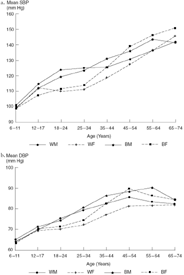
Figure 23.4 (A) Systolic blood pressure (SBP) by age, gender, and ethnicity. Adapted from Pyörälä et al. (1987 [23]). Abbreviations: WM, White male; WF, White female; BM, Black male; BF, Black female. (B) Diastolic blood pressure (DBP) by age, gender, and ethnicity. Adapted from Rowland and Roberts (1982 [24]). Abbreviations: WM, White male; WF, White female; BM, Black male; BF, Black female.
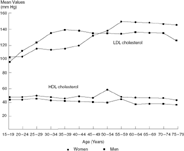
Figure 23.5. Age trends in lipoprotein-cholesterol fractions. Adapted from Kannel (1988 [33]). Abbreviations: LDL, low-density lipoprotein; HDL, high-density lipoprotein.
Hyperlipidemia Previous epidemiologic data have demonstrated a nonlinear relationship between serum cholesterol and cardiovascular risk: a 2% increase in cardiovascular risk for every 1% increase in serum total cholesterol above 200 mg/dl.30 The components of total cholesterol are subfractionated on the basis of density ultracentrifugation and confer differing degrees of cardiovascular risk. In men and women, LDL is directly correlated with risk, whereas HDL inversely correlates with 31,32 In addition, lipid levels change in men and women as a function of age. In premenopausal women, serum total and LDL cholesterol levels are generally lower than in men. Levels of HDL cholesterol are uniformly higher in women than in men at all ages. However, following menopause, and beginning in the premenopausal years, LDL cholesterol levels in women rise to higher levels than do men's (see Figure 23.5).33 Levels of HDL in women fall slightly in postmenopause. Low HDL levels (40–45 mg/dl) in women appear to confer greater increased risk
In general, hypertriglyceridemia and elevations in very low density lipoprotein (VLDL) cholesterol have not been clearly demonstrated to be associated with equivalent relative cardiovascular risk in men and 36–38 Elevations of VLDL triglycerides confer greater relative risk in women as compared to men.39 The reasons for these differences are not presently clear but may in part relate to resultant interactions with other parameters associated with hypertriglyceridemia, including low HDL cholesterol, obesity, and low levels of exercise. In addition, hypertriglyceridemia in women may be less amenable to modification. For example, aerobic exercise training has been demonstrated to affect blood lipids differently and less favorably in women compared to men.40
Myth #3: Changing Hormonal Status
and Menopause Confound Our Understanding
of the Impact of Heart Disease in Women
Menopause An important physical and emotional transition in the lives of women is menopause, which is associated with a dramatic alteration in the vascular hormonal milieu, including a fall in estrogen levels. The sheer number of CHD risk parameters that are affected when a woman attains menopause, or age greater than 55 (the age by which most women are postmenopausal), strongly implies a role for menopause as an independent risk factor for CHD.41 Menopause, whether natural or surgical, is associated with a two- to fourfold increase in CHD risk 41,42 (see Figure 23.6). A proportionately greater risk increase is seen the younger a woman is at the time of menopause.43,44 As current life expectancy for women is greater than 80 years, many women will spend
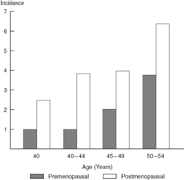
Figure 23.6. Annual incidence of cardiovascular disease per 1,000 women (by menopause status). Adapted from Department of Health, Education, and Welfare Publication 74, 1974, Framingham Study.
It is of interest that hysterectomy, perhaps the most frequently performed surgery on women, has also been postulated to be associated with an increase in CHD risk. The mechanism of risk enhancement may be associated with loss of uterine prostacyclin, a potent vascular vasodilator and inhibitor of platelet aggregation.44 Keen interest also currently exists in evaluating the perimenopausal period, a period characterized by a changing hormonal status, as a time of accelerating CHD risk in women.
Myth #4: No Gender Differences Exist in Therapeutic
Treatment Approaches and Their Applications
for Men and Women with CHD
The health care costs associated with treatment for CHD are staggering 45 and highlight the need for judicious utilization of currently available management options. Yet there is little information regarding the benefits and efficacy of treatment and management options for women with CHD. The lack of information stems partly from past exclusion of women in clinical studies due to fear of pregnancy during an investigative trial and from concerns that fluctuations in hormone status in women would be a confounding variable in data interpretation. As a result, much of the available information on cardiovascular therapeutic interventions comes from studies done primarily in men. The relevance and appropriateness of applying the results of studies in men to women has been questioned. Currently, conventional medical and surgical treatment for women with CHD is not associated with similar benefits as for men. Women with CHD are underdiagnosed and undertreated when compared to male counterparts, resulting in delay in diagnosis and possible adverse outcomes. This section evaluates gender differences in the management of CHD.
Diagnostic Studies Chest pain, the most common presenting symptom of CHD in women, is often dismissed as a symptom of CHD. This stems in part from lack of physician awareness of women's risks for CHD, such as premenopausal women with a significant number of additional risk factors,46,47 and discomfort with limitations of diagnostic modalities in women. Other factors contributing to the underdiagnosis of CHD in women include women's misperceptions of CHD as a health threat and the consequent dismissal, denial, or minimizing of symptoms; a higher frequency of noncardiac conditions associated with chest pain syndromes in women (e.g., mitral valve prolapse and anxiety disorders); a lower prevalence of CHD in women when compared to men of similar age; and exaggerated concerns of limitations of diagnostic testing in women. Although exercise treadmill testing is associated with a higher false-positive rate in women 47,48 and the interpretation of nuclear medicine scans can be hampered by breast artifact and breast attenuation,48 both of these diagnostic studies remain useful in the evaluation of chest pain and ischemia in women.
Invasive Procedures and Revascularization Gender differences have been reported in utilization rates of invasive cardiovascular procedures for men and women, with women undergoing significantly fewer invasive procedures.49 Specifically, women are referred for coronary arteriography, coronary angioplasty, and coronary artery bypass surgery at nearly half the rate as men,50–53 even after the diagnosis of CHD has been established. The differences observed have been attributed to a variety of factors, including possible referral bias, inadequate access to care, more advanced age and overall poorer health status of elderly women, and anatomic considerations. Support for these postulates is provided by data from the Coronary Artery Surgery Study (CASS),54 which indicated that women who undergo bypass surgery are typically sicker, more often require emergency surgery, and are referred for revascularization at a later and more symptomatic stage of their illness than men. In addition, the CASS study demonstrated that women undergoing bypass grafting had mortality rates two times greater than those for men, less initial and later symptomatic relief from angina, and shorter long-term graft patency rates. Therefore, bypass surgery may carry greater risks and be less efficacious in women as compared to men. Similarly, women have excess mortality after percutaneous transluminal coronary angioplasty.55 Therefore, women may experience greater risks than men do with reperfusion and revascularization. The reasons for these differences are unclear but may in part relate to some of the factors mentioned previously and to anatomic variables, including smaller caliber coronary vessels and greater vessel friability as a direct result of hormonal vascular effects.
Medical Treatment Gender differences in response to pharmacologic management of CHD may be anticipated because of differences in body size, fat distribution, protein binding, and drug-drug interactions. The Nurses's Health Initiative Study 56 is the largest trial to date to include an investigation of the benefits of aspirin in women. This study found that aspirin use by women led to a 37% reduction in cardiovascular risk. The risk benefit was of similar magnitude to that previously established for men by the British Doctor's Study and other studies in men. Unfortunately, little comparable data are available regarding benefits to women who have been prescribed calcium channel blockers or beta blockers, other than the well-established benefits of beta blockers post-MI. Angiotensin converting enzyme inhibitors, used extensively for management
| Study | Subjects | Outcome |
|---|---|---|
aFrom Journal of the American Medical Association 242(23), 2572–2577. | ||
bFrom The Lancet 1 (1818): 1261–1267. | ||
cFrom British medical Journal 291(6488), 97–104. | ||
dFrom The Lancet 1 (8442): 1349–1354. | ||
| Hypertension Detection and Follow-Up Program (1979)[a] | 10,940 (46% female) | Female (Black)—28% reduction in mortality |
| Male (Black)—19% reduction in mortality | ||
| Male (White)—15% reduction in mortality | ||
| Female (White)—3% reduction in mortality | ||
| Australian Therapeutic Trial (1980)[b] | 3,427 (37% female) | Male—26% reduction total end points p<.05 |
| Female—26% reduction in end points p = not significant | ||
| Medical Research Council Trial of Treatment of Mild Hypertension (1985)[c] | 17,534 (48% female) | Female—26% INCREASE in all cause mortality |
| Male—15% decrease in all cause mortality | ||
| European Working Party on High Blood Pressure in the Elderly(1985)[d] | 840 (70% female) | Female—18% decrease in cardiovascular mortality |
| Male—47% decrease in cardiovascular mortality | ||
Hormone Use, Hormone Replacement Therapy, and CHD Risk Past use of oral contraceptives has not been linked to increased risk of cardiovascular disease,57–59 with the well-recognized exception of enhanced thrombotic potential in women who are smokers, over the age of 35, and on oral contraceptives.60 In addition, most epidemiologic studies of
| Study | Subjects | Outcome |
|---|---|---|
| NOTE: SK, streptokinase; ASA, aspirin; TPA, tissue plasminogen activator. European, European Trial (American Journal of Cardiology 63[17], 1185–1192, 1989); GISSI, Gruppo Italiano per lo Studio della Streptochinasi nell Infarto Miocardico (The Lancet 2[8564], 871–874, 1987); ISIS II, Second International Study of Infarct Survival (The Lancet 2[8607], 349–360, 1988); ASSET, Anglo-Scandinavian Study of Early Thrombolysis (The Lancet 2[8610], 525–530, 1988); MILIS, Multi-Centre Investigation of the Limitation of Infarct Size (Journal of the American College of Cardiology 9[3], 473–482, 1987). | ||
| European Trial (SK, heparin) | 730 (133 females) | Males—30% reduction mortality |
| Females—24% eduction mortality | ||
| GISSI (SK) | 11,806 (1,157 females) | Males—8.8% mortality |
| Females—18.5% mortality | ||
| ISIS II (SK, ASA) | 17,000 (4,000 females) | Males—44% reduction mortality |
| Females—30% reduction mortality | ||
| ASSET (TPA, heparin) | 5,000 (1,151 females) | Males—28% reduction mortality |
| Females—21% reduction mortality | ||
| MILIS (hyaluronidase and propanolol) | 816 (226 females) | Males—21% cumulative mortality |
| Females—36% cumulative mortality | ||
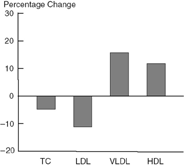
Figure 23.7. Effects of estrogen on lipid parameters. Source: Adapted from Paganini-Hill et al. (1988 [69]). Abbreviations: TC, total cholesterol; LDL, low-density lipoprotein; VLDL, very low density lipoprotein; HDL, high-density lipoprotein.
The mechanisms by which estrogen affords cardioprotection are multifactorial. In addition to benefits from chronic use, estrogen has been demonstrated to have acute effects on the vasculature.70 Estrogen acts at several steps in the atherogenic process to prevent cardiovascular disease. Some of the benefits of estrogen (approximately one-fourth to onehalf of the CHD risk reduction) are ascribed to its ability to favorably alter the lipoprotein profile (see Figure 23.7).71 Oral conjugated estrogens are associated with the greatest benefit on the lipid profile, resulting in approximately 15% reductions in LDL cholesterol (from accelerated LDL catabolism) and a similar rise in HDL cholesterol levels.71 Lipid benefits of lesser magnitude have been reported with the use of other formulations and delivery routes. Estrogen replacement is associated with a significant, though highly variable, rise in VLDL triglyceride levels 72 (resulting from increased production of large, triglyceride-rich VLDL).71 The significance of hypertriglyceridemia as a consequence of HRT on CHD risk is unclear when compared to that of endogenous hypertrygliceridemia.
Despite the currently known benefits of HRT, estimates of noncompliance range from 15% to 41%.75 The figures are particularly significant given the extent of cardiovascular risk and mortality reductions afforded by HRT, as demonstrated by studies to date. Elderly women, the highest-risk group for CHD, may face conflicts relating to the perception that CHD is a natural consequence of aging. Compliance is also affected by uncertainty regarding the risks of HRT.
The major well-established deleterious effect of unopposed estrogen therapy in women with a uterus is a three- to fourfold increase in the risk of endometrial cancer.72,76,77 The rationale for combination therapy with estrogen and progestins in women with a uterus is that the addition of progestin protects the endometrium from prolonged stimulation with unopposed estrogen, thereby reducing the risk of endometrial cancer. In general, progestins alone attenuate the lipid effects of estrogen. However, as clearly demonstrated by the recent Postmenopausal Estrogen and Progesterone Intervention (PEPI) Trial,72 if progestins are given in combination with estrogen, favorable effects on lipid parameters continue to be evident. Whether progestins attenuate the cardioprotective effects of estrogens is unclear at this time, as the effects on CHD risk and mortality resulting from combined estrogen and progesterone HRT have not been conclusively evaluated by studies to date. Data on the potential increase in risk for breast cancer from HRT remain inconclusive and will have to await clarification from future studies.78–82
Cardioprotective effects of estrogen cannot be explained solely on the basis of lipid changes, however. Recent studies indicate that a number of additional mechanisms are of significance. It appears that a substantial portion of the cardioprotective effects of estrogen may be mediated by direct effects on the vessel wall, leading to an attenuation of aortic cholesterol accumulation.83–85 Estrogens have also been demonstrated to prevent oxidative modification of LDL cholesterol.86 Other beneficial effects of estrogen include direct actions in decreased expression of adhesion molecules involved in monocyte adhesion to endothelium and in altering vasoreactivity of atherosclerotic vessels and thereby promoting vasodilation.87 Furthermore, reductions in fibrinogen levels have also been reported with HRT in postmenopausal women (PEPI trial). Despite mounting evidence on the benefits of HRT, relatively few physicians prescribe hormonal therapy to their patients with CHD or lipid abnormalities, and many women are reluctant to accept such therapy.